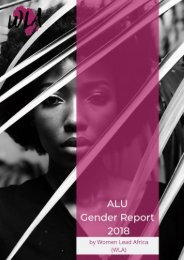You also want an ePaper? Increase the reach of your titles
YUMPU automatically turns print PDFs into web optimized ePapers that Google loves.
Brief History of State of African<br />
Women<br />
In many countries across the world, the role of women has been minimized based on the long<br />
tradition of their exclusion from education and development. The participation of particularly African<br />
women in economic, social, political and cultural sectors was affected by cultural barriers and low<br />
expectations by and of females. Organisational and institutional cultures of universities, in general,<br />
were established to meet the needs of male faculty and students. Patterns of leadership, beliefs,<br />
symbols, structures, ceremonies, power and information flow (Carrol and Mills, 2006) are modelled<br />
on masculine expectations and experiences and this in turn resulted in very few African women in<br />
tertiary institutions over the years.<br />
Africa’s new investments in higher education are the result of significant strides in expanding access<br />
to primary and secondary schooling for both genders. Yet the ‘massification of higher education’<br />
across the continent has not yielded comparable developments towards gender parity as measured<br />
by the Global Gender Gap Index (GGGI) despite the significant change globally. According to the<br />
2015 GGGI, Sub-Saharan Africa has made the most progress toward narrowing its educational<br />
attainment gender gap over 2014. But disparities between male and female higher education gross<br />
enrollment rate (GER) ratios persist.<br />
Rwanda, the highest ranked African country (6th) by GGGI has a male ratio of 8.64% and a female<br />
one of 6.64%. Chad, the lowest ranked African country, on the other hand (142nd) has a male GER of<br />
5.74% and a female GER of 1.4%. The research identifies gender inequality in higher institutions of<br />
learning as a key factor that contributes to the marginalisation of women in the workplace.<br />
The last 60+ years have seen the number of women in the workplace globally significantly increase.<br />
Women entered the economic system to supplement the male earning capacity which had been lost<br />
to the two world wars. Despite the evolution globally, African women were still relatively<br />
underrepresented in the workplace with only significant changes happening in the last 10 years.<br />
10




